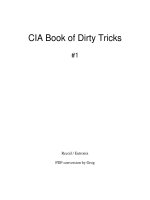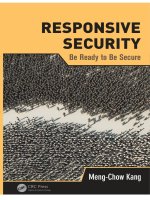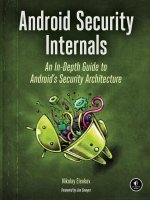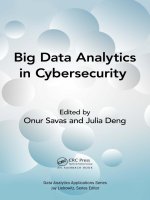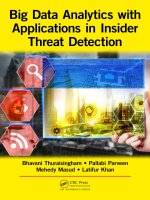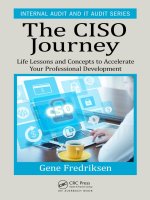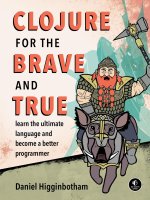Hacking ebook thinklikeaprogrammer
Bạn đang xem bản rút gọn của tài liệu. Xem và tải ngay bản đầy đủ của tài liệu tại đây (8.75 MB, 257 trang )
• Split problems into discrete components to make
them easier to solve
• Make the most of code reuse with functions, classes,
and libraries
CO
Although the book’s examples are written in C++, the
creative problem-solving concepts they illustrate go beyond
any particular language; in fact, they often reach outside the
realm of computer science. As the most skillful programmers
know, writing great code is a creative art—and the first
step in creating your masterpiece is learning to Think Like
a Programmer.
ABOUT THE AUTHOR
T H E F I N E ST I N G E E K E N T E RTA I N M E N T ™
w w w.nostarch.com
“ I L I E F L AT .”
$34.95 ($36.95 CDN)
SHELVE IN:
PROGRAMMING/GENERAL
This book uses RepKover — a durable binding that won’t snap shut.
I N T R O D U C T I O N
T O
CREATIVE PROBLEM SOLVING
V. ANTON SPRAUL
DE
EAT
V. Anton Spraul has taught introductory programming and
computer science for more than 15 years. This book is a
distillation of the techniques he has used and honed over
many one-on-one sessions with struggling programmers.
He is also the author of Computer Science Made Simple.
A N
CO
You’ll also learn how to:
• Organize your thoughts and develop strategies to tackle
particular types of problems
THINK LIKE
A PROGR AMMER
EEP
SL
EEP
SL
CO
EEP
SL
In this one-of-a-kind text, author V. Anton Spraul breaks
down the ways that programmers solve problems and
teaches you what other introductory books often ignore:
how to Think Like a Programmer. Each chapter tackles
a single programming concept, like classes, pointers,
and recursion, and open-ended exercises throughout
challenge you to apply your knowledge.
• Master more advanced programming tools like recursion
and dynamic memory
THINK LIKE A PROGR AMMER
The real challenge of programming isn’t learning a
language’s syntax—it’s learning to creatively solve
problems so you can build something great.
• Pick the perfect data structure for a particular job
EAT
EAT
REWIRE
YOUR BRAIN
DE
DE
TLAP_02.backup.book Page i Monday, November 14, 2016 5:17 PM
THINK LIKE A PROGRAMMER
TLAP_02.backup.book Page ii Monday, November 14, 2016 5:17 PM
TLAP_02.backup.book Page iii Monday, November 14, 2016 5:17 PM
THINK LIKE A
PROGRAMMER
An Introduction to
Creative Problem Solving
by V. Anton Spraul
San Francisco
TLAP_02.backup.book Page iv Monday, November 14, 2016 5:17 PM
THINK LIKE A PROGRAMMER. Copyright © 2012 by V. Anton Spraul.
All rights reserved. No part of this work may be reproduced or transmitted in any form or by any means, electronic or
mechanical, including photocopying, recording, or by any information storage or retrieval system, without the prior
written permission of the copyright owner and the publisher.
19 18 17 16
56789
ISBN-10: 1-59327-424-6
ISBN-13: 978-1-59327-424-5
Publisher: William Pollock
Production Editor: Alison Law
Cover Design: Charlie Wylie
Interior Design: Octopod Studios
Developmental Editor: Keith Fancher
Technical Reviewer: Dan Randall
Copyeditor: Julianne Jigour
Compositor: Susan Glinert Stevens
Proofreader: Ward Webber
For information on distribution, translations, or bulk sales, please contact No Starch Press, Inc. directly:
No Starch Press, Inc.
245 8th Street, San Francisco, CA 94103
phone: 1.415.863.9900;
www.nostarch.com
Library of Congress Cataloging-in-Publication Data
Spraul, V. Anton.
Think like a programmer : an introduction to creative problem solving / V. Anton Spraul.
pages cm
ISBN 978-1-59327-424-5 (pbk.) -- ISBN 1-59327-424-6 (pbk.)
1. Computer programming. 2. Creative thinking. 3. Problem solving. I. Title.
QA76.6.S685 2012
005.1--dc23
2012020396
No Starch Press and the No Starch Press logo are registered trademarks of No Starch Press, Inc. Other product and
company names mentioned herein may be the trademarks of their respective owners. Rather than use a trademark
symbol with every occurrence of a trademarked name, we are using the names only in an editorial fashion and to the
benefit of the trademark owner, with no intention of infringement of the trademark.
The information in this book is distributed on an “As Is” basis, without warranty. While every precaution has been
taken in the preparation of this work, neither the author nor No Starch Press, Inc. shall have any liability to any
person or entity with respect to any loss or damage caused or alleged to be caused directly or indirectly by the
information contained in it.
TLAP_02.backup.book Page v Monday, November 14, 2016 5:17 PM
BRIEF CONTENTS
Acknowledgments .......................................................................................................... xi
Introduction ................................................................................................................. xiii
Chapter 1: Strategies for Problem Solving ..........................................................................1
Chapter 2: Pure Puzzles .................................................................................................25
Chapter 3: Solving Problems with Arrays .........................................................................55
Chapter 4: Solving Problems with Pointers and Dynamic Memory .......................................81
Chapter 5: Solving Problems with Classes ......................................................................111
Chapter 6: Solving Problems with Recursion ...................................................................143
Chapter 7: Solving Problems with Code Reuse................................................................171
Chapter 8: Thinking Like a Programmer .........................................................................195
Index .........................................................................................................................227
TLAP_02.backup.book Page vi Monday, November 14, 2016 5:17 PM
TLAP_02.backup.book Page vii Monday, November 14, 2016 5:17 PM
CONTENTS IN DETAIL
A C KN O W L E D G M E N T S
INTRODUCTION
xi
xiii
About This Book ...................................................................................................... xv
Prerequisites .............................................................................................. xv
Chosen Topics ........................................................................................... xv
Programming Style .................................................................................... xvi
Exercises .................................................................................................. xvi
Why C++? ...............................................................................................xvii
1
STRATEGIES FOR PROBLEM SOLVING
1
Classic Puzzles ........................................................................................................ 2
The Fox, the Goose, and the Corn ................................................................ 3
Problem: How to Cross the River? ....................................................................... 3
Sliding Tile Puzzles ...................................................................................... 7
Problem: The Sliding Eight .................................................................................. 7
Problem: The Sliding Five ................................................................................... 8
Sudoku .................................................................................................... 11
Problem: Completing a Sudoku Square ............................................................. 11
The Quarrasi Lock ..................................................................................... 13
Problem: Opening the Alien Lock ...................................................................... 13
General Problem-Solving Techniques ........................................................................ 15
Always Have a Plan .................................................................................. 16
Restate the Problem ................................................................................... 17
Divide the Problem .................................................................................... 17
Start with What You Know ......................................................................... 18
Reduce the Problem ................................................................................... 19
Look for Analogies .................................................................................... 20
Experiment ............................................................................................... 20
Don’t Get Frustrated .................................................................................. 21
Exercises ............................................................................................................... 22
2
PURE PUZZLES
25
Review of C++ Used in This Chapter ........................................................................ 26
Output Patterns ...................................................................................................... 26
Problem: Half of a Square ................................................................................ 26
Problem: A Square (Half of a Square Reduction) ............................................... 27
Problem: A Line (Half of a Square Further Reduction) ......................................... 27
Problem: Count Down by Counting Up .............................................................. 28
Problem: A Sideways Triangle .......................................................................... 29
Input Processing ..................................................................................................... 31
Problem: Luhn Checksum Validation ................................................................. 31
Breaking Down the Problem ....................................................................... 33
TLAP_02.backup.book Page viii Monday, November 14, 2016 5:17 PM
Problem: Convert Character Digit to Integer ...................................................... 35
Problem: Luhn Checksum Validation, Fixed Length ............................................ 36
Problem: Simple Checksum Validation, Fixed Length ......................................... 36
Problem: Positive or Negative .......................................................................... 39
Putting the Pieces Together ......................................................................... 39
Tracking State ........................................................................................................ 41
Problem: Decode a Message ............................................................................ 41
Problem: Reading a Number with Three or Four Digits ...................................... 45
Problem: Reading a Number with Three or Four Digits, Further Simplified .......... 46
Conclusion ............................................................................................................ 53
Exercises ............................................................................................................... 53
3
SOLVING PROBLEMS WITH ARRAYS
55
Review of Array Fundamentals ................................................................................. 56
Store ....................................................................................................... 56
Copy ....................................................................................................... 57
Retrieval and Search ................................................................................. 57
Sort ........................................................................................................ 59
Compute Statistics ..................................................................................... 61
Solving Problems with Arrays ................................................................................... 62
Problem: Finding the Mode .............................................................................. 62
Refactoring ............................................................................................... 65
Arrays of Fixed Data .............................................................................................. 67
Non-scalar Arrays .................................................................................................. 69
Multidimensional Arrays .......................................................................................... 71
Deciding When to Use Arrays ................................................................................. 74
Exercises ............................................................................................................... 78
4
SOLVING PROBLEMS WITH POINTERS AND
DYNAMIC MEMORY
81
Review of Pointer Fundamentals ............................................................................... 82
Benefits of Pointers ................................................................................................. 83
Runtime-Sized Data Structures ..................................................................... 83
Resizable Data Structures ........................................................................... 83
Memory Sharing ....................................................................................... 84
When to Use Pointers ............................................................................................. 84
Memory Matters ..................................................................................................... 85
The Stack and the Heap ............................................................................. 86
Memory Size ............................................................................................ 88
Lifetime .................................................................................................... 90
Solving Pointer Problems ......................................................................................... 91
Variable-Length Strings ............................................................................... 91
Problem: Variable-Length String Manipulation .................................................. 91
Linked Lists ............................................................................................. 101
Problem: Tracking an Unknown Quantity of Student Records ........................... 101
Conclusion and Next Steps ................................................................................... 108
Exercises ............................................................................................................. 109
viii
Contents i n Detail
TLAP_02.backup.book Page ix Monday, November 14, 2016 5:17 PM
5
SOLVING PROBLEMS WITH CLASSES
111
Review of Class Fundamentals ............................................................................... 112
Goals of Class Use ............................................................................................... 113
Encapsulation ......................................................................................... 114
Code Reuse ............................................................................................ 114
Dividing the Problem ............................................................................... 115
Information Hiding .................................................................................. 115
Readability ............................................................................................. 117
Expressiveness ........................................................................................ 117
Building a Simple Class ........................................................................................ 118
Problem: Class Roster .................................................................................... 118
The Basic Class Framework ...................................................................... 119
Support Methods ..................................................................................... 122
Classes with Dynamic Data ................................................................................... 125
Problem: Tracking an Unknown Quantity of Student Records ........................... 126
Adding a Node ...................................................................................... 128
Rearranging the List ................................................................................. 130
Destructor ............................................................................................... 133
Deep Copy ............................................................................................. 134
The Big Picture for Classes with Dynamic Memory ....................................... 139
Mistakes to Avoid ................................................................................................ 140
The Fake Class ........................................................................................ 140
Single-Taskers ......................................................................................... 141
Exercises ............................................................................................................. 141
6
SOLVING PROBLEMS WITH RECURSION
143
Review of Recursion Fundamentals ......................................................................... 144
Head and Tail Recursion ....................................................................................... 144
Problem: How Many Parrots? ......................................................................... 144
Approach 1 ............................................................................................ 145
Approach 2 ............................................................................................ 146
Problem: Who’s Our Best Customer? .............................................................. 148
Approach 1 ............................................................................................ 149
Approach 2 ............................................................................................ 151
The Big Recursive Idea .......................................................................................... 152
Problem: Computing the Sum of an Array of Integers ...................................... 153
Common Mistakes ................................................................................................ 155
Too Many Parameters .............................................................................. 155
Global Variables ..................................................................................... 156
Applying Recursion to Dynamic Data Structures ....................................................... 158
Recursion and Linked Lists ........................................................................ 158
Problem: Counting Negative Numbers in a Singly Linked List ........................... 159
Recursion and Binary Trees ...................................................................... 160
Problem: Find the Largest Value in a Binary Tree ............................................. 162
Wrapper Functions ............................................................................................... 163
Problem: Find the Number of Leaves in a Binary Tree ...................................... 163
When to Choose Recursion ................................................................................... 165
Arguments Against Recursion .................................................................... 166
Contents in D etai l
ix
TLAP_02.backup.book Page x Monday, November 14, 2016 5:17 PM
Problem: Display a Linked List in Order .......................................................... 168
Problem: Display a Linked List in Reverse Order .............................................. 168
Exercises ............................................................................................................. 170
7
SOLVING PROBLEMS WITH CODE REUSE
171
Good Reuse and Bad Reuse .................................................................................. 172
Review of Component Fundamentals ...................................................................... 173
Code Block ............................................................................................ 173
Algorithms .............................................................................................. 173
Patterns .................................................................................................. 174
Abstract Data Types ................................................................................ 175
Libraries ................................................................................................. 175
Building Component Knowledge ............................................................................ 176
Exploratory Learning ................................................................................ 176
Problem: The First Student .............................................................................. 177
As-Needed Learning ................................................................................ 180
Problem: Efficient Traversal ............................................................................ 180
Choosing a Component Type ................................................................................ 188
Component Choice in Action .................................................................... 189
Problem: Sorting Some, Leaving Others Alone ................................................ 189
Comparing the Results ............................................................................. 193
Exercises ............................................................................................................. 193
8
THINKING LIKE A PROGRAMMER
195
Creating Your Own Master Plan ............................................................................ 196
Playing to Your Strengths and Weaknesses ................................................ 196
Putting the Master Plan Together ............................................................... 202
Tackling Any Problem ........................................................................................... 203
Problem: Cheating at Hangman ..................................................................... 204
Finding a Way to Cheat .......................................................................... 205
Required Operations for Cheating at Hangman .......................................... 206
Initial Design .......................................................................................... 208
Initial Coding .......................................................................................... 210
Analysis of Initial Results .......................................................................... 217
The Art of Problem Solving ....................................................................... 218
Learning New Programming Skills .......................................................................... 219
New Languages ...................................................................................... 219
New Skills for a Language You Already Know ............................................ 222
New Libraries ......................................................................................... 223
Take a Class ........................................................................................... 223
Conclusion .......................................................................................................... 224
Exercises ............................................................................................................. 225
INDEX
x
Contents in D e ta i l
227
TLAP_02.backup.book Page xi Monday, November 14, 2016 5:17 PM
ACKNOWLEDGMENTS
No book is truly the work of one author, and I’ve received lots of help on
Think Like a Programmer.
I’m grateful to everyone at No Starch Press, especially Keith Fancher and
Alison Law, who edited, shaped, and shepherded the book throughout its
production. I must also thank Bill Pollock for his decision to sign me up in
the first place—I hope he is as pleased with the result as I am. The folks at
No Starch have been unfailingly kind and helpful in their correspondence
with me. I hope one day to meet them in person and see to what degree they
resemble their cartoon avatars on the company website.
Dan Randall did a wonderful job as technical editor. His numerous suggestions beyond the technical review helped me strengthen the manuscript
in many areas.
On the home front, the most important people in my life, Mary Beth
and Madeline, provided love, support, and enthusiasm—and, crucially, time
to write.
Finally, to all the students of programming I’ve had over the years:
Thank you for letting me be your teacher. The techniques and strategies
described in this book were developed through our joint efforts. I hope
we’ve made the journey easier for the next generation of programmers.
TLAP_02.backup.book Page xii Monday, November 14, 2016 5:17 PM
TLAP_02.backup.book Page xiii Monday, November 14, 2016 5:17 PM
INTRODUCTION
EAT
CO
DE
EEP
SL
Do you struggle to write programs, even
though you think you understand programming languages? Are you able to read through
a chapter in a programming book, nodding
your head the whole way, but unable to apply what
you’ve read to your own programs? Are you able to
comprehend a program example you’ve read online, even to the point where
you could explain to someone else what each line of the code is doing,
yet you feel your brain seize up when faced with a programming task and a
blank screen in your text editor?
You’re not alone. I have taught programming for over 15 years, and most
of my students would have fit this description at some point in their instruction. We will call the missing skill problem solving, the ability to take a given
problem description and write an original program to solve it. Not all programming requires extensive problem solving. If you’re just making minor
modifications to an existing program, debugging, or adding testing code, the
TLAP_02.backup.book Page xiv Monday, November 14, 2016 5:17 PM
programming may be so mechanical in nature that your creativity is never
tested. But all programs require problem solving at some point, and all good
programmers can solve problems.
Problem solving is hard. It’s true that a few people make it look easy—
the “naturals,” the programming world’s equivalent of a gifted athlete, like
Michael Jordan. For these select few, high-level ideas are effortlessly translated
into source code. To make a Java metaphor, it’s as if their brains execute Java
natively, while the rest of us have to run a virtual machine, interpreting as we go.
Not being a natural isn’t fatal to becoming a programmer—if it were, the
world would have few programmers. Yet I’ve seen too many worthy learners
struggle too long in frustration. In the worst cases, they give up programming
entirely, convinced that they can never be programmers, that the only good
programmers are those born with an innate gift.
Why is learning to solve programming problems so hard?
In part, it’s because problem solving is a different activity from learning
programming syntax and therefore uses a different set of mental “muscles.”
Learning programming syntax, reading programs, memorizing elements of
an application programming interface—these are mostly analytical “left brain”
activities. Writing an original program using previously learned tools and
skills is a creative “right brain” activity.
Suppose you need to remove a branch that has fallen into one of the rain
gutters on your house, but your ladder isn’t quite long enough for you to
reach the branch. You head into your garage and look for something, or a
combination of things, that will enable you to remove the branch from the
gutter. Is there some way to extend the ladder? Is there something you can
hold at the top of the ladder to grab or dislodge the branch? Maybe you could
just get on the roof from another place and get the branch from above. That’s
problem solving, and it’s a creative activity. Believe it or not, when you design
an original program, your mental process is quite similar to that of the person
figuring out how to remove the branch from the gutter and quite different
from that of a person debugging an existing for loop.
Most programming books, though, focus their attention on syntax and
semantics. Learning the syntax and semantics of a programming language is
essential, but it’s only the first step in learning how to program in that language. In essence, most programming books for beginners teach how to read
a program, not how to write one. Books that do focus on writing are often
effectively “cookbooks” in that they teach specific “recipes” for use in particular situations. Such books can be quite valuable as time savers, but not as a
path toward learning to write original code. Think about cookbooks in the
original sense. Although great cooks own cookbooks, no one who relies upon
cookbooks can be a great cook. A great cook understands ingredients, preparation methods, and cooking methods and knows how they can be combined
to make great meals. All a great cook needs to produce a tasty meal is a fully
stocked kitchen. In the same way, a great programmer understands language
syntax, application frameworks, algorithms, and software engineering principles and knows how they can be combined to make great programs. Give a
great programmer a list of specifications, turn him loose with a fully stocked
programming environment, and great things will happen.
xiv
I n t r od u c t i o n
TLAP_02.backup.book Page xv Monday, November 14, 2016 5:17 PM
In general, current programming education doesn’t offer much guidance
in the area of problem solving. Instead, it’s assumed that if programmers are
given access to all of the tools of programming and requested to write enough
programs, eventually they will learn to write such programs and write them
well. There is truth in this, but “eventually” can be a long time. The journey
from initiation to enlightenment can be filled with frustration, and too many
who start the journey never reach the destination.
Instead of learning by trial and error, you can learn problem solving in a
systematic way. That’s what this book is all about. You can learn techniques to
organize your thoughts, procedures to discover solutions, and strategies to
apply to certain classes of problems. By studying these approaches, you can
unlock your creativity. Make no mistake: Programming, and especially problem solving, is a creative activity. Creativity is mysterious, and no one can say
exactly how the creative mind functions. Yet, if we can learn music composition, take advice on creative writing, or be shown how to paint, then we can
learn to creatively solve programming problems, too. This book isn’t going
to tell you precisely what to do; it’s going to help you develop your latent
problem-solving abilities so that you will know what you should do. This book
is about helping you become the programmer you are meant to be.
My goal is for you and every other reader of this book to learn to systematically approach every programming task and to have the confidence that
you will ultimately solve a given problem. When you complete this book, I
want you to think like a programmer and to believe that you are a programmer.
About This Book
Having explained the necessity of this book, I need to make a few comments
about what this book is and what it is not.
Prerequisites
This book assumes you are already familiar with the basic syntax and semantics of the C++ language and that you have begun writing programs. Most of
the chapters will expect you to know specific C++ fundamentals; these chapters will begin with a review of those fundamentals. If you are still absorbing
language basics, don’t worry. There are plenty of great books on C++ syntax,
and you can learn problem solving in parallel to learning syntax. Just make
sure you have studied the relevant syntax before attempting to tackle a chapter’s problems.
Chosen Topics
The topics covered in this book represent areas in which I have most often
seen new programmers struggle. They also present a broad cross-section of
different areas in early and intermediate programming.
I should emphasize, however, that this is not a “cookbook” of algorithms
or patterns for solving specific problems. Although later chapters discuss
how to employ well-known algorithms or patterns, you should not use this
I n t r od u ct i on
xv
TLAP_02.backup.book Page xvi Monday, November 14, 2016 5:17 PM
book as a “crib sheet” to get you past particular problems or focus on just the
chapters that directly relate to your current struggles. Instead, I would work
through the entire book, skipping material only if you lack the prerequisites
needed to follow the discussion.
Programming Style
A quick note here about the programming style employed in this book: This
book is not about high-performance programming or running the most compact, efficient code. The style I have chosen for the source code examples is
intended to be readable above all other considerations. In some cases, I take
multiple steps to accomplish something that could be done in one step, just so
the principle I’m trying to demonstrate is made clear.
Some aspects of programming style will be covered in this book—but
larger issues, like what should or should not be included in a class, not small
issues, like how code should be indented. As a developing programmer, you
will of course want to employ a consistent, readable style in all of the work
you do.
Exercises
The book includes a number of programming exercises. This is not a textbook, and you won’t find answers to any of the exercises in the back. The
exercises provide opportunities for you to apply the concepts described in
the chapters. Whether you choose to try any of the exercises is, of course, up
to you, but it is essential that you put these concepts into practice. Simply
reading through the book will accomplish nothing. Remember that this book
is not going to tell you exactly what to do in each situation. In applying the
techniques shown in this book, you will develop your own ability to discover
what to do. Furthermore, growing your confidence, another primary goal of
this book, requires success. In fact, that’s a good way to know when you have
worked through enough exercises in a given problem area: when you are confident that you can tackle other problems in the area. Lastly, programming
exercises should be fun. While there may be moments where you’d rather be
doing something else, working out a programming problem should be a
rewarding challenge.
You should think of this book as an obstacle course for your brain. Obstacle
courses build strength, stamina, and agility and give the trainer confidence.
By reading through the chapters and applying the concepts to as many exercises as you can, you’re going to build confidence and develop problem-solving
skills that can be used in any programming situation. In the future, when you
are faced with a difficult problem, you’ll know whether you should try going
over, under, or through it.
xvi
I n t r od u c t i o n
TLAP_02.backup.book Page xvii Monday, November 14, 2016 5:17 PM
Why C++?
The programming examples in this text are coded using C++. Having said
that, this book is about solving problems with programs, not specifically
about C++. You won’t find many tips and tricks specific to C++ here, and the
general concepts taught throughout this book can be employed in any programming language. Nevertheless, you can’t discuss programming without
discussing programs, and a specific language had to be chosen.
C++ was selected for a number of reasons. First, it’s popular in a variety
of problem areas. Second, because of its origins in the strictly procedural C
language, C++ code can be written using both the procedural and objectoriented paradigms. Object-oriented programming is so common now that it
could not be omitted from a discussion on problem solving, but many fundamental problem-solving concepts can be discussed in strictly procedural
programming terms, and doing so simplifies both the code and the discussion. Third, as a low-level language with high-level libraries, C++ allows us to
discuss both levels of programming. The best programmers can “hand-wire”
solutions when required and make use of high-level libraries and application
programming interfaces to reduce development time. Lastly, and partly as a
function of the other reasons listed, C++ is a great choice because once you
have learned to solve problems in C++, you have learned to solve problems in
any programming language. Many programmers have discovered how the
skills learned in one language easily apply to other languages, but this is especially true for C++ because of its cross-paradigm approach and, frankly, because
of its difficulty. C++ is the real deal—it’s programming without training wheels.
This is daunting at first, but once you start succeeding in C++, you’ll know
that you’re not going to be someone who can do a little coding—you’re going
to be a programmer.
I nt r o d u c t i o n
xvii
TLAP_02.backup.book Page xviii Monday, November 14, 2016 5:17 PM
TLAP_02.backup.book Page 1 Monday, November 14, 2016 5:17 PM
STRATEGIES FOR
PROBLEM SOLVING
EAT
This book is about problem solving, but
what is problem solving, exactly? When
people use the term in ordinary conversation,
they often mean something very different from
what we mean here. If your 1997 Honda Civic has blue
smoke coming from the tailpipe, is idling roughly, and
EEP
SL
CO
DE
has lost fuel efficiency, this is a problem that can be solved with automotive
knowledge, diagnosis, replacement equipment, and common shop tools. If
you tell your friends about your problem, though, one of them might say,
“Hey, you should trade that old Honda in for something new. Problem solved.”
But your friend’s suggestion wouldn’t really be a solution to the problem—it
would be a way to avoid the problem.
Problems include constraints, unbreakable rules about the problem or
the way in which the problem must be solved. With the broken-down Civic,
one of the constraints is that you want to fix the current car, not purchase a
new car. The constraints might also include the overall cost of the repairs,
how long the repair will take, or a requirement that no new tools can be purchased just for this repair.
TLAP_02.backup.book Page 2 Monday, November 14, 2016 5:17 PM
When solving a problem with a program, you also have constraints. Common constraints include the programming language, platform (does it run
on a PC, or an iPhone, or what?), performance (a game program may require
graphics to be updated at least 30 times a second, a business application
might have a maximum time response to user input), or memory footprint.
Sometimes the constraint involves what other code you can reference: Maybe
the program can’t include certain open-source code, or maybe the opposite—
maybe it can use only open source.
For programmers, then, we can define problem solving as writing an original
program that performs a particular set of tasks and meets all stated constraints.
Beginning programmers are often so eager to accomplish the first part
of that definition—writing a program to perform a certain task—that they
fail on the second part of the definition, meeting the stated constraints. I call
a program like that, one that appears to produce correct results but breaks
one or more of the stated rules, a Kobayashi Maru. If that name is unfamiliar
to you, it means you are insufficiently familiar with one of the touchstones of
geek culture, the film Star Trek II: The Wrath of Khan. The film contains a subplot about an exercise for aspiring officers at Starfleet Academy. The cadets
are put aboard a simulated starship bridge and made to act as captain on a
mission that involves an impossible choice. Innocent people will die on a
wounded ship, the Kobayashi Maru, but to reach them requires starting a
battle with the Klingons, a battle that can only end in the destruction of the
captain’s ship. The exercise is intended to test a cadet’s courage under fire.
There’s no way to win, and all choices lead to bad outcomes. Toward the end
of the film, we discover that Captain Kirk modified the simulation to make it
actually winnable. Kirk was clever, but he did not solve the dilemma of the
Kobayashi Maru; he avoided it.
Fortunately, the problems you will face as a programmer are solvable,
but many programmers still resort to Kirk’s approach. In some cases, they do
so accidentally. (“Oh, shoot! My solution only works if there are a hundred
data items or fewer. It’s supposed to work for an unlimited data set. I’ll have
to rethink this.”) In other cases, the removal of constraints is deliberate, a
ploy to meet a deadline imposed by a boss or an instructor. In still other
cases, the programmer just doesn’t know how to meet all of the constraints.
In the worst cases I have seen, the programming student has paid someone
else to write the program. Regardless of the motivations, we must always be
diligent to avoid the Kobayashi Maru.
Classic Puzzles
As you progress through this book, you will notice that although the particulars of the source code change from one problem area to the next, certain
patterns will emerge in the approaches we take. This is great news because
this is what eventually allows us to confidently approach any problem, whether
we have extensive experience in that problem area or not. Expert problem
2
Chapter 1
TLAP_02.backup.book Page 3 Monday, November 14, 2016 5:17 PM
solvers are quick to recognize an analogy, an exploitable similarity between
a solved problem and an unsolved problem. If we recognize that a feature
of problem A is analogous to a feature of problem B and we have already
solved problem B, we have a valuable insight into solving problem A.
In this section, we’ll discuss classic problems from outside the world of
programming that have lessons we can apply to programming problems.
The Fox, the Goose, and the Corn
The first classic problem we will discuss is a riddle about a farmer who needs
to cross a river. You have probably encountered it previously in one form or
another.
PROBLEM: HOW TO CROSS THE RIVER?
A farmer with a fox, a goose, and a sack of corn needs to cross a river. The farmer
has a rowboat, but there is room for only the farmer and one of his three items. Unfortunately, both the fox and the goose are hungry. The fox cannot be left alone with the
goose, or the fox will eat the goose. Likewise, the goose cannot be left alone with the
sack of corn, or the goose will eat the corn. How does the farmer get everything
across the river?
The setup for this problem is shown in Figure 1-1. If you have never
encountered this problem before, stop here and spend a few minutes trying
to solve it. If you have heard this riddle before, try to remember the solution
and whether you were able to solve the riddle on your own.
Far Shore
SACK
O’
CORN
Near Shore
Figure 1-1: The fox, the goose, and the sack of corn. The boat can
carry one item at a time. The fox cannot be left on the same shore as
the goose, and the goose cannot be left on the same shore as the sack
of corn.
S t r a t e g i e s f o r P r ob l e m So lv in g
3
TLAP_02.backup.book Page 4 Monday, November 14, 2016 5:17 PM
Few people are able to solve this riddle, at least without a hint. I know I
wasn’t. Here’s how the reasoning usually goes. Since the farmer can take only
one thing at a time, he’ll need multiple trips to take everything to the far
shore. On the first trip, if the farmer takes the fox, the goose would be left
with the sack of corn, and the goose would eat the corn. Likewise, if the farmer
took the sack of corn on the first trip, the fox would be left with the goose,
and the fox would eat the goose. Therefore, the farmer must take the goose
on the first trip, resulting in the configuration shown in Figure 1-2.
Far Shore
SACK
O’
CORN
Near Shore
Figure 1-2: The required first step for solving the problem of the fox, the
goose, and the sack of corn. From this step, however, all further steps
appear to end in failure.
So far, so good. But on the second trip, the farmer must take the fox or
the corn. Whatever the farmer takes, however, must be left on the far shore
with the goose while the farmer returns to the near shore for the remaining
item. This means that either the fox and goose will be left together or the
goose and corn will be left together. Because neither of these situations is
acceptable, the problem appears unsolvable.
Again, if you have seen this problem before, you probably remember the
key element of the solution. The farmer has to take the goose on the first
trip, as explained before. On the second trip, let’s suppose the farmer takes
the fox. Instead of leaving the fox with the goose, though, the farmer takes the
goose back to the near shore. Then the farmer takes the sack of corn across,
leaving the fox and the corn on the far shore, while returning for a fourth
trip with the goose. The complete solution is shown in Figure 1-3.
This puzzle is difficult because most people never consider taking one of
the items back from the far shore to the near shore. Some people will even
suggest that the problem is unfair, saying something like, “You didn’t say I
could take something back!” This is true, but it’s also true that nothing in the
problem description suggests that taking something back is prohibited.
4
Chapter 1
TLAP_02.backup.book Page 5 Monday, November 14, 2016 5:17 PM
1
2
3
The “Trick” Step
5
4
6
7
8
Figure 1-3: Step-by-step solution to the fox, goose, and corn puzzle
Think about how much easier the puzzle would be to solve if the possibility of taking one of the items back to the near shore was made explicit:
The farmer has a rowboat that can be used to transfer items in either direction, but
there is room only for the farmer and one of his three items. With that suggestion in
plain sight, more people would figure out the problem. This illustrates an
important principle of problem solving: If you are unaware of all possible
actions you could take, you may be unable to solve the problem. We can
refer to these actions as operations. By enumerating all the possible operations, we can solve many problems by testing every combination of operations until we find one that works. More generally, by restating a problem
in more formal terms, we can often uncover solutions that would have otherwise eluded us.
S t r a t e g i e s f o r P r ob l e m So lv in g
5
TLAP_02.backup.book Page 6 Monday, November 14, 2016 5:17 PM
Let’s forget that we already know the solution and try stating this particular puzzle more formally. First, we’ll list our constraints. The key constraints
here are:
1.
The farmer can take only one item at a time in the boat.
2.
The fox and goose cannot be left alone on the same shore.
3.
The goose and corn cannot be left alone on the same shore.
This problem is a good example of the importance of constraints. If we
remove any of these constraints, the puzzle is easy. If we remove the first constraint, we can simply take all three items across in one trip. Even if we can
take only two items in the boat, we can take the fox and corn across and then
go back for the goose. If we remove the second constraint (but leave the other
constraints in place), we just have to be careful, taking the goose across first,
then the fox, and finally the corn. Therefore, if we forget or ignore any of the
constraints, we will end up with a Kobayashi Maru.
Next, let’s list the operations. There are various ways of stating the operations for this puzzle. We could make a specific list of the actions we think we
can take:
1.
Operation: Carry the fox to the far side of the river.
2.
Operation: Carry the goose to the far side of the river.
3.
Operation: Carry the corn to the far side of the river.
Remember, though, that the goal of formally restating the problem is to
gain insight for a solution. Unless we have already solved the problem and
discovered the “hidden” possible operation, taking the goose back to the
near side of the river, we’re not going to discover it in making our list of
actions. Instead, we should try to make operations generic, or parameterized.
1.
Operation: Row the boat from one shore to the other.
2.
Operation: If the boat is empty, load an item from the shore.
3.
Operation: If the boat is not empty, unload the item to the shore.
By thinking about the problem in the most general terms, this second list of
operations will allow us to solve the problem without the need for an “ah-hah!”
moment regarding the trip back to the near shore with the goose. If we generate all possible sequences of moves, ending each sequence once it violates
one of our constraints or reaches a configuration we’ve seen before, we will
eventually hit upon the sequence of Figure 1-3 and solve the puzzle. The
inherent difficulty of the puzzle will have been sidestepped through the
formal restatement of constraints and operations.
6
Chapter 1
